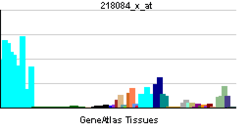FXYD5
FXYD domain-containing ion transport regulator 5 is a protein that in humans is encoded by the FXYD5 gene.[3]
Function
This reference sequence was derived from AF161462.1 and ESTs; validated by multiple replicate ESTs and human genomic sequence. This gene encodes a member of a family of small membrane proteins that share a 35-amino acid signature sequence domain, beginning with the sequence PFXYD and containing 7 invariant and 6 highly conserved amino acids. The approved human gene nomenclature for the family is FXYD-domain containing ion transport regulator. Mouse FXYD5 has been termed RIC (Related to Ion Channel). FXYD2, also known as the gamma subunit of the Na,K-ATPase, regulates the properties of that enzyme. FXYD1 (phospholemman), FXYD2 (gamma), FXYD3 (MAT-8), FXYD4 (CHIF), and FXYD5 (RIC) have been shown to induce channel activity in experimental expression systems. Transmembrane topology has been established for two family members (FXYD1 and FXYD2), with the N-terminus extracellular and the C-terminus on the cytoplasmic side of the membrane. This gene product, FXYD5, has not been characterized as a protein. Two transcript variants have been found for this gene, and they are both predicted to encode the same protein.[3]
References
Further reading
- Nam JS, Hirohashi S, Wakefield LM (Oct 2007). "Dysadherin: a new player in cancer progression". Cancer Letters. 255 (2): 161–9. doi:10.1016/j.canlet.2007.02.018. PMC 2094007
 . PMID 17442482.
. PMID 17442482.
- Adams MD, Kerlavage AR, Fleischmann RD, Fuldner RA, Bult CJ, Lee NH, Kirkness EF, Weinstock KG, Gocayne JD, White O (Sep 1995). "Initial assessment of human gene diversity and expression patterns based upon 83 million nucleotides of cDNA sequence" (PDF). Nature. 377 (6547 Suppl): 3–174. PMID 7566098.
- Sweadner KJ, Rael E (Aug 2000). "The FXYD gene family of small ion transport regulators or channels: cDNA sequence, protein signature sequence, and expression". Genomics. 68 (1): 41–56. doi:10.1006/geno.2000.6274. PMID 10950925.
- Zhang QH, Ye M, Wu XY, Ren SX, Zhao M, Zhao CJ, Fu G, Shen Y, Fan HY, Lu G, Zhong M, Xu XR, Han ZG, Zhang JW, Tao J, Huang QH, Zhou J, Hu GX, Gu J, Chen SJ, Chen Z (Oct 2000). "Cloning and functional analysis of cDNAs with open reading frames for 300 previously undefined genes expressed in CD34+ hematopoietic stem/progenitor cells". Genome Research. 10 (10): 1546–60. doi:10.1101/gr.140200. PMC 310934
 . PMID 11042152.
. PMID 11042152.
- Omasa T, Chen YG, Mantalaris A, Wu JH (Jan 2001). "A cDNA from human bone marrow encoding a protein exhibiting homology to the ATP1gamma1/PLM/MAT8 family of transmembrane proteins". Biochimica et Biophysica Acta. 1517 (2): 307–10. doi:10.1016/S0167-4781(00)00251-7. PMID 11342114.
- Ino Y, Gotoh M, Sakamoto M, Tsukagoshi K, Hirohashi S (Jan 2002). "Dysadherin, a cancer-associated cell membrane glycoprotein, down-regulates E-cadherin and promotes metastasis". Proceedings of the National Academy of Sciences of the United States of America. 99 (1): 365–70. doi:10.1073/pnas.012425299. PMC 117566
 . PMID 11756660.
. PMID 11756660.
- Sato H, Ino Y, Miura A, Abe Y, Sakai H, Ito K, Hirohashi S (Sep 2003). "Dysadherin: expression and clinical significance in thyroid carcinoma". The Journal of Clinical Endocrinology and Metabolism. 88 (9): 4407–12. doi:10.1210/jc.2002-021757. PMID 12970317.
- Shimada Y, Yamasaki S, Hashimoto Y, Ito T, Kawamura J, Soma T, Ino Y, Nakanishi Y, Sakamoto M, Hirohashi S, Imamura M (Apr 2004). "Clinical significance of dysadherin expression in gastric cancer patients". Clinical Cancer Research. 10 (8): 2818–23. doi:10.1158/1078-0432.CCR-0633-03. PMID 15102690.
- Shimada Y, Hashimoto Y, Kan T, Kawamura J, Okumura T, Soma T, Kondo K, Teratani N, Watanabe G, Ino Y, Sakamoto M, Hirohashi S, Imamura M (2004). "Prognostic significance of dysadherin expression in esophageal squamous cell carcinoma". Oncology. 67 (1): 73–80. doi:10.1159/000080289. PMID 15459499.
- Shimamura T, Yasuda J, Ino Y, Gotoh M, Tsuchiya A, Nakajima A, Sakamoto M, Kanai Y, Hirohashi S (Oct 2004). "Dysadherin expression facilitates cell motility and metastatic potential of human pancreatic cancer cells". Cancer Research. 64 (19): 6989–95. doi:10.1158/0008-5472.CAN-04-1166. PMID 15466191.
- Wu D, Qiao Y, Kristensen GB, Li S, Troen G, Holm R, Nesland JM, Suo Z (2005). "Prognostic significance of dysadherin expression in cervical squamous cell carcinoma". Pathology Oncology Research. 10 (4): 212–8. doi:10.1007/BF03033763. PMID 15619642.
- Nishizawa A, Nakanishi Y, Yoshimura K, Sasajima Y, Yamazaki N, Yamamoto A, Hanada K, Kanai Y, Hirohashi S (Apr 2005). "Clinicopathologic significance of dysadherin expression in cutaneous malignant melanoma: immunohistochemical analysis of 115 patients". Cancer. 103 (8): 1693–700. doi:10.1002/cncr.20984. PMID 15751018.
- Batistatou A, Scopa CD, Ravazoula P, Nakanishi Y, Peschos D, Agnantis NJ, Hirohashi S, Charalabopoulos KA (Dec 2005). "Involvement of dysadherin and E-cadherin in the development of testicular tumours". British Journal of Cancer. 93 (12): 1382–7. doi:10.1038/sj.bjc.6602880. PMC 2361540
 . PMID 16333245.
. PMID 16333245.
- Batistatou A, Makrydimas G, Zagorianakou N, Zagorianakou P, Nakanishi Y, Agnantis NJ, Hirohashi S, Charalabopoulos K (2007). "Expression of dysadherin and E-cadherin in trophoblastic tissue in normal and abnormal pregnancies". Placenta. 28 (5-6): 590–2. doi:10.1016/j.placenta.2006.09.004. PMID 17084448.
- Batistatou A, Peschos D, Tsanou H, Charalabopoulos A, Nakanishi Y, Hirohashi S, Agnantis NJ, Charalabopoulos K (May 2007). "In breast carcinoma dysadherin expression is correlated with invasiveness but not with E-cadherin". British Journal of Cancer. 96 (9): 1404–8. doi:10.1038/sj.bjc.6603743. PMC 2360179
 . PMID 17437014.
. PMID 17437014.

 . PMID 17442482.
. PMID 17442482. . PMID 11042152.
. PMID 11042152. . PMID 11756660.
. PMID 11756660. . PMID 16333245.
. PMID 16333245. . PMID 17437014.
. PMID 17437014.